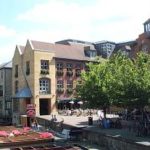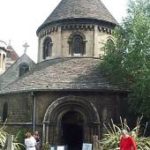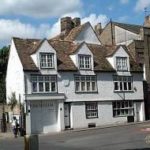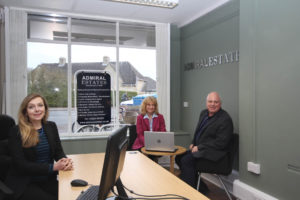Welcome to Admiral Estate Agents Cambridge and Letting Agents Cambridge



Setting Standards Beyond Expectation
- Sales and Lettings
- Property Renovation/Development
- Local, Independent Estate Agents in Cambridge
- 20 Years Experience (Established in 1995)
- Bespoke / Expert Service
- Pre-Sale /Pre-Rental Advice
- Buy-To-Let
- Friendly, Experienced Staff
- Ethical, Online Sales Process
"Blending Tradition with Technology - To Make Things Better!" - To find out how click here
Admiral estate agents Cambridge are an independent, local agent offering a bespoke, specialist service for discerning clients. We combine 20 years local knowledge and experience with state of the art marketing and an integrity culture. Our services include: Property Sales and Lettings, Property Acquisition, Property Development and Renovation in Cambridge and surrounding areas.
Admiral are transparent, realistic and flexible. We aim to understand your needs and provide the best tailored, professional advice and service.
Admiral Estates operate from two office locations in both Central Cambridge and in the Linton / Saffron Walden / Haverhill Area
Admiral Estates - Testimonials:
Please take the time to visit our estate agents cambridge testimonials pages. We are proud of the relationships we have with all our Letting Agents Cambridge clients. We think that what our clients have to say about us is more important than anything we could say about ourselves!
Estate Agents Cambridge - Redefining the Standard :
Proven Management Formula
We guarantee that our simple formula will help you to achieve higher net returns from your property:
Sales: High Quality Presentation + Instant Reporting + High Quality Customer Service + High Visibility = High Value Sales!
Lettings: Happy "Looked After" Tenants + Controlled Maintenance + Fewer Gaps = Higher Long Term Returns!
For your peace of mind, Admiral are fully registered and regulated by the following professional bodies:
(Click the image to find out more about these bodies and what they mean to you):
Cambridge Estate Agent, Sales and Lettings Coverage:
Admiral Estate market property across Cambridge and surrounding villages. Areas covered are Central Cambridge, North Cambridge, East Cambridge, South Cambridge and West Cambridge. The following Post code areas are covered: CB1, CB2, CB3, CB4, CB5, CB6, CB7, CB8, CB9, CB10, CB11, CB21, CB22, CB23, CB24 and CB25.
Cambridge Today:
Most of us associate Cambridge with a combination both the past and the future. We are all aware of the rapid expansion and prosperity surrounding the Cambridge Region. As far as residential property in Cambridge is concerned, both Sales and Lettings are particularly buoyant and look set to continue long into the future. If you are interested in Cambridge Property, we thought it would help to expand on the reasons behind Cambridge's Success.
Historically, southern and central areas of Cambridge have experienced higher demand than villages to the north of Cambridge.However, May 2017 sees the opening of a new railway station, situated next to the science park A14 / A10 junction. This is a mainline station with direct trains to London Kings Cross, Ipswich and Norwich. This assures increasing demand for property to the north of Cambridge as well as benefiting the City as a whole.
SO.......Why Is Cambridge So Successful:
Source: http://www.cambridgephenomenon.com
Set against the backdrop of the University of Cambridge, Cambridge City has evolved into one of the world's most enterprising networks of people and companies. For many years, the Cambridge Phenomenon has been the subject of business, economic, political and academic interest for those directly or indirectly involved in its companies. Our goal is to promote that interest and try to answer some of the questions that arise from the debate.
There are now around 1,000 technology and biotechnology companies in the cluster, 1,400 when providers of services and support organizations are included. More than 40,000 people have come to or stayed in the Cambridge region to work in these companies and this number doubles when their families are included. The economic, social and environmental impact of these companies and the people they attract are evident everywhere.
Following the Mott Report in 1970, Trinity College took the decision to create what became the Cambridge Science Park. The St. John's Innovation Centre followed in 1988 to provide accommodation for fledgling entrepreneurial companies. Initiative such as these prompted a new era of collaboration between academia and the private sector that continues to influence the growth and prosperity of the Cambridge Phenomenon.
HOW DID IT START?
Arguably, entrepreneurial behaviour has been part of the Cambridge scene for eight hundred years, since the first monks undertook the trek from Oxford to establish what became the colleges and University of Cambridge. Other early examples include the founding of Cambridge University Press in 1534, the Cambridge Scientific Instrument Company, established by Charles Darwin's son Horace in 1881, Pye in 1896 and Marshall's in 1909.
But none of these prepared the region for the emergence in the past fifty years of today's vibrant community of entrepreneurial companies. Founded in 1960 by two Cambridge graduates – Tim Eiloart and David Southward – to "put the brains of Cambridge University at disposal of the problems of British industry", Cambridge Consultants was the catalyst for what is indisputably the UK's if not Europe's leading technology cluster.
THE FUTURE OF THE CAMBRIDGE PHENOMENON
The human race faces a number of global issues - Climate Change, Education, Energy, Food, Health, Security and Water. None of these can be solved by any one science or for that matter science alone. Solutions will need to be cross-disciplinary and multi-disciplinary, embracing science, technology, engineering, economics, politics, industry and commerce.
Within the context of Cambridge, combining leading science and technology from within the University with the experience of local entrepreneurs and those attracted from around the world to be part of the Cambridge Phenomenon, provides the opportunity for expansion of existing companies and the founding of new enterprises to address these global issues.
In the 50 years of the Cambridge Phenomenon, there have been many examples of spin-outs and company start-ups which directly and indirectly leveraged science, technology and people from the University and combined them with the experience and business acumen of entrepreneurs to create successful companies. There has never been a greater need or opportunity for intensification of this over the coming decades.
Brief History Of Cambridge:
Source: Cambridge History: http://www.colc.co.uk/cambridge/cambridge/history.htm
Cambridge is most famous for its historic university. However, Cambridge is far older than the university.
 The original settlement was north of the river, on Castle Hill. There is evidence for pre-Roman activity in the area, but the Romans built the first town. It was a convenient crossing point of the river Cam, on the edge of the marshy fen land. The town was a port, since it was the head of the navigation of what was then known as the River Granta. The area by Magdalene Bridge is still known as Quayside (see left), although now it only has punts. St Peter's Church, halfway up Castle Hill, has pieces of Roman tiles in its walls.
The original settlement was north of the river, on Castle Hill. There is evidence for pre-Roman activity in the area, but the Romans built the first town. It was a convenient crossing point of the river Cam, on the edge of the marshy fen land. The town was a port, since it was the head of the navigation of what was then known as the River Granta. The area by Magdalene Bridge is still known as Quayside (see left), although now it only has punts. St Peter's Church, halfway up Castle Hill, has pieces of Roman tiles in its walls.
In Anglo Saxon times, there was a settlement on Castle Hill, since it could be defended, and another close to St Benedict's Church, or St Bene't's as it's known in Cambridge. The tower of St Bene't's is Saxon (see left), which makes it the oldest building in Cambridge. The city at the time was called Grantabrycge. At one time it came under Danish rule. St Clement's Church is near Quayside, and this dedication is common in Danish settlements. The Great Bridge (later replaced by Magdalene Bridge) may have built by King Offa (756-793AD). It was the last river crossing until King's Lynn. Cambridge had good trading links to the Continent and a market, and became prosperous.
 The Normans built a castle on Castle Hill in 1068. It was particularly important to fortify Cambridge, since Hereward the Wake was defying Norman rule nearby in Ely. All that is left of the castle is Castle Mound (see right) and a few stones in the grounds of Shire Hall, off Castle Hill, belonging to Cambridgeshire County Council. If you climb to the top of the mound, you get a good view of Cambridge. It is the highest point of Cambridge, and allegedly, if you go north in a straight line, there is no higher ground until you reach the North Pole!
The Normans built a castle on Castle Hill in 1068. It was particularly important to fortify Cambridge, since Hereward the Wake was defying Norman rule nearby in Ely. All that is left of the castle is Castle Mound (see right) and a few stones in the grounds of Shire Hall, off Castle Hill, belonging to Cambridgeshire County Council. If you climb to the top of the mound, you get a good view of Cambridge. It is the highest point of Cambridge, and allegedly, if you go north in a straight line, there is no higher ground until you reach the North Pole!
 The Church of the Holy Sepulchre (usually known in Cambridge as the Round Church) is one of only four round Norman church in England (see left). They were built by the Knights Templar. The round arches are typical of Norman church architecture. The Leper chapel on Newmarket Road is another Norman chapel.
The Church of the Holy Sepulchre (usually known in Cambridge as the Round Church) is one of only four round Norman church in England (see left). They were built by the Knights Templar. The round arches are typical of Norman church architecture. The Leper chapel on Newmarket Road is another Norman chapel.
By now, the town was known as Grentebrige or Cantebrigge. Eventually the name became Cambridge. However, the river was still called the Granta. Someone thought "Cambridge must be the bridge over the Cam, so the river should be called the Cam instead of the Granta", and so the river's name was changed! Upstream, where it flows through Grantchester, the River is still called the Granta. The Latin name for Cambridge is Cantabrigia, which is why degrees are called Cantab. This was not the Roman name for the town. The Roman settlement was called Duroliponte.
Barnwell Priory was founded in 1092, originally on Castle Hill, but later moved to area now known as Riverside, by the Elizabeth Way bridge. There is little left now apart from a church, St Andrews the Less, and a building known as the Cellarer's Checker (see right). There were many other religious houses founded in Cambridge, including St Rhadegund's Nunnery, which gave its name to Maid's Causeway, and later became Jesus College. King John granted a charter to Cambridge in 1201. The city council still own the charter of 1207.
 The first recorded date connected with Cambridge University was 1209, when some Oxford students moved to Cambridge. Peterhouse, the first college, was founded in 1284. From this point, various colleges were founded. Some amalgamated previous colleges, or took over from priories, such as St Rhadegund. Corpus Christi was founded by the Guilds of Cambridge. As the university grew, trouble broke out between Town, the people who lived in Cambridge, and Gown, the students. The centre of the town was now definitely within the loop of the river, although you can still see older houses on the lower parts of Castle Hill, such as the Cambridge Folk Museum or Museum of Cambridge, as it is now called (see left).
The first recorded date connected with Cambridge University was 1209, when some Oxford students moved to Cambridge. Peterhouse, the first college, was founded in 1284. From this point, various colleges were founded. Some amalgamated previous colleges, or took over from priories, such as St Rhadegund. Corpus Christi was founded by the Guilds of Cambridge. As the university grew, trouble broke out between Town, the people who lived in Cambridge, and Gown, the students. The centre of the town was now definitely within the loop of the river, although you can still see older houses on the lower parts of Castle Hill, such as the Cambridge Folk Museum or Museum of Cambridge, as it is now called (see left).
Another old building is the School of Pythagoras in St John's college, the oldest University building in Cambridge still in active use, but originally a town house.
 Henry VIII removed control of the university colleges from the religious bodies which had previously controlled them. There was a lot building at this time, including most of the splendid gatehouses (see left), and Kings College Chapel was finished (see left).
Henry VIII removed control of the university colleges from the religious bodies which had previously controlled them. There was a lot building at this time, including most of the splendid gatehouses (see left), and Kings College Chapel was finished (see left).
Oliver Cromwell was educated at Sidney Sussex College, and was elected Member of Parliament for Cambridge in 1640. Previously he had been MP for Huntingdon. He became Lord Protector of England, and beheaded King Charles I. After Cromwell died, Charles II became king, and Cromwell's head was displayed as the head of a traitor. The head is now buried in Sidney Sussex college, but they won't say where! Cromwell now has a statue outside the House of Commons in London.
 In 1614, Cambridge needed a new water supply. Thomas Hobson built a causeway bringing water from springs at Nine Wells near Shelford outside Cambridge into the city centre. The channels still run along Trumpington Street (see right), although the conduit fountain has been moved from the market place to the corner of Lensfield Road (see left). Thomas Hobson hired out horses, but hirers had to take the horse closest to the door. This led to the expression "Hobson's Choice" meaning "No choice"! There is a Hobson Street in the centre of Cambridge.
In 1614, Cambridge needed a new water supply. Thomas Hobson built a causeway bringing water from springs at Nine Wells near Shelford outside Cambridge into the city centre. The channels still run along Trumpington Street (see right), although the conduit fountain has been moved from the market place to the corner of Lensfield Road (see left). Thomas Hobson hired out horses, but hirers had to take the horse closest to the door. This led to the expression "Hobson's Choice" meaning "No choice"! There is a Hobson Street in the centre of Cambridge.
William Harvey (1578–1657) discovered the circulation of the blood. He studied at Gonville & Caius College.
Isaac Newton (1643-1727) made fundamental discoveries about gravity and light, and invented calculus. He was at Trinity College.
Charles Darwin was at Christ's College. His book "The Origin of the Species" described how different animal species could evolve by natural selection.
There were no colleges founded from 1594 to 1800, and this was a time of decline, both in the university and the town. However, in late Victorian times, there were several colleges founded, including the first women's colleges (although degrees were not awarded to women until 1948). The university was developed as a centre of scientific research, based at the Cavendish Labs and the Downing Site (see right).
Judges Institute:
Judges Institute Famous scientists at Cambridge include:
William Harvey (see above)
Isaac Newton (see above)
Charles Darwin (see above)
Ernest Rutherford split the atom in 1903
Crick and Watson discovered the structure of DNA in 1953
Professor Stephen Hawking wrote Brief History of Time in 1988
There have been many famous writers connected with Cambridge as well.
In 1845 the railway reached Cambridge, and the Barnwell Enclosure Act of 1806 allowed development of the town to the south and east. Cambridge became a city in 1951. Twentieth century development was mostly to the north, east and south. The size of the city did not grow for some time, because of planning restrictions. There is some striking modern architecture in Cambridge, such as the Judges Institute (see left). Future development of the city is under consideration, and the university is expanding to the west. For an account of modern Cambridge, see Cambridge economy.
Thank you for visiting Admiral Estate Agents Cambridge and Letting Agents Cambridge.
Please take a look at the Admiral Estate Agents Cambridge and Letting Agents Cambridge Site.








